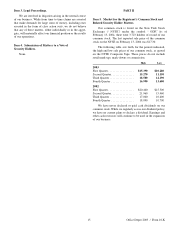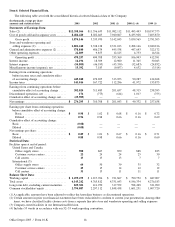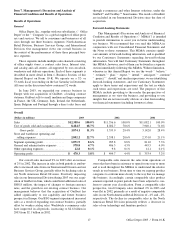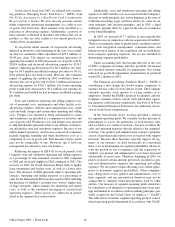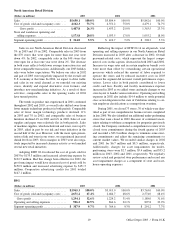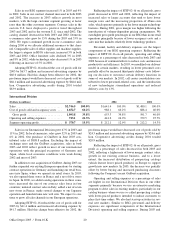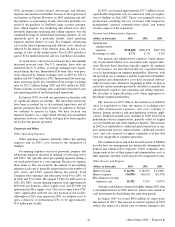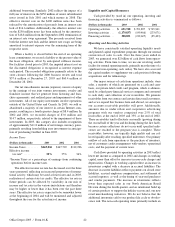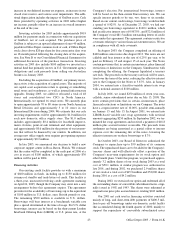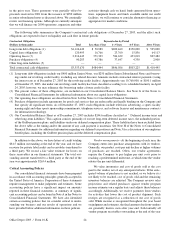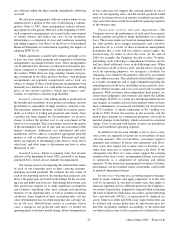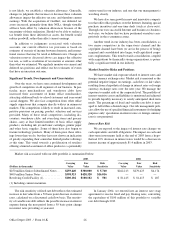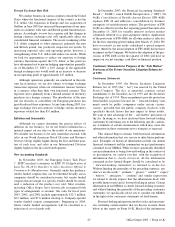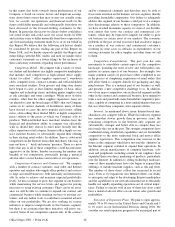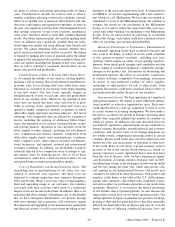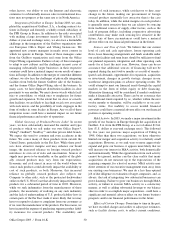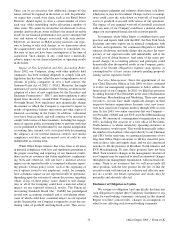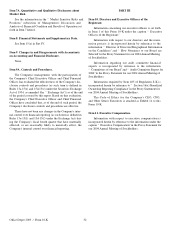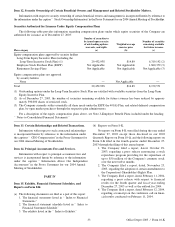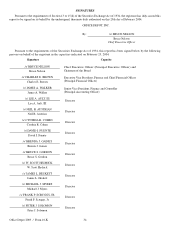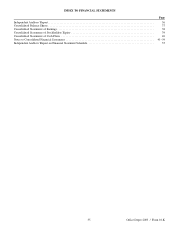Office Depot 2003 Annual Report Download - page 27
Download and view the complete annual report
Please find page 27 of the 2003 Office Depot annual report below. You can navigate through the pages in the report by either clicking on the pages listed below, or by using the keyword search tool below to find specific information within the annual report.are collected within the three months immediately following
year-end.
We also have arrangements with our vendors where we are
reimbursed for a portion of the costs of advertising a vendor’s
product. Prior to 2003, these arrangements reduced advertis-
ing expense for the period. Effective at the beginning of 2003,
such cooperative arrangements are treated in the same manner
as vendor rebates and reduce the costs of our inventory.
Advertising is a component of store and warehouse operating
and selling expenses. See Note C of the Notes to Consolidated
Financial Statements for information regarding the impact of
adopting EITF 02-16.
While agreements reached with vendors generally cover
at least one year, vendor program and cooperative advertising
arrangements can change between years. These arrangements
can be influenced by increases or reductions in inventory pur-
chases compared to company plans and programs offered by
the vendors. While there are long-standing volume and pric-
ing conventions in the office products business, such program
arrangements are regularly renegotiated, and as such, are
subject to change. If these vendor program arrangements were
materially less beneficial, we could either increase the selling
price of the vendor’s product, which may impact sales
volume, or experience a decline in profitability.
Inventory valuation—Our selling model is predicated on
the breadth and availability of our product assortment, and our
profitability is dependent on high inventory turnover rates.
Our merchants monitor inventory on hand by location, partic-
ularly as it relates to trailing and projected sales trends. Once
a product has been flagged for discontinuance, we record a
charge to reduce the product cost to our assessment of the
lower of cost or market. This assessment is based on the quality
of the merchandise, the rate of sale, and our assessment of the
market conditions. Additional cost adjustments and sales
markdowns will be taken as considered appropriate until the
product is sold or otherwise disposed. Estimates and judg-
ments are required in determining what items to stock and at
what level, and what items to discontinue and how to value
them prior to sale.
Goodwill testing—Under accounting rules that became
effective at the beginning of fiscal 2002, goodwill is no longer
amortized but is tested at least annually for impairment.
Our testing consists of comparing the estimated fair values
of each of our reporting units to their carrying amounts,
including recorded goodwill. We estimate the fair values of
each of our reporting units by discounting their projected cash
flows. Our projections are based on the budget for the succeed-
ing year and multi-year forecasts. Developing these future cash
flow projections requires us to make significant assumptions
and estimates regarding sales, gross margin and operating
expenses of our reporting units, as well as assumed economic
conditions. Since adoption of these accounting rules, our fair
value determination has exceeded reporting unit carrying val-
ues in all cases. Should future results or economic events
cause a change in our projected cash flows, or should our
operating plans or business model change, future determinations
of fair value may not support the carrying amount of one or
more of our reporting units, and the related goodwill would
need to be written down to an amount considered recoverable.
Any such write down would be included in operating expenses
of the business unit.
Closed store reserves and asset impairments—The
Company assesses the performance of each retail store against
historic patterns and projects future profitability on a regular
basis. These assessments are based on management’s estimates
for sales growth, gross margin attainments, and cash flow
generation. If as a result of these evaluations management
determines that a store will not achieve certain targets, the
decision may be made to close the store. At the end of
2000, for example, the Company decided to close 70 under-
performing stores following a comprehensive business review
and has closed additional stores in the following years. When
the decision is made to close a store, and the store is no longer
used for operating purposes, we recognize a liability for
remaining costs related to the property, reduced by an estimate
of any sublease income. The calculation of this liability requires
us to make assumptions and to apply judgment regarding the
remaining term on the lease (including vacancy period), antic-
ipated sublease income, and costs associated with vacating the
premises. With assistance from independent third parties, we
review these judgments and estimates and adjust the liability
accordingly. In 2003, as a result of a detailed portfolio review
and changes in commercial real estate markets where we have
lease commitments, we increased our liability for closed stores
by $23.9 million. A similar adjustment of $6.7 million was
made in 2002. Future fluctuations in the economy and the
market place demand for commercial properties can result in
material changes in the liability, which can result in a material
charge. Costs associated with facility closures are included in
store and warehouse operating expenses.
In addition to the decision whether or not to close a store,
store assets are regularly reviewed for recoverability of their
carrying amounts. The recoverability assessment requires
judgment and estimates of future store generated cash flows.
New stores may require two or more years to develop a cus-
tomer base necessary to achieve expected cash flows. If the
anticipated cash flows of a store cannot support the carrying
amount of the store’s assets, an impairment charge is recorded
to operations as a component of operating and selling
expenses. To the extent that management’s estimates of future
performance are not realized, future assessments could result
in material impairment charges.
Income taxes—Income tax accounting requires manage-
ment to make estimates and apply judgments to events that
will be recognized in one period under rules that apply to
financial reporting and in a different period in the Company’s
tax returns. In particular, judgment is required when estimating
the value of future tax deductions, tax credits, and net operating
loss carryforwards (NOLs), as represented by deferred tax
assets. Some tax credits and NOLs may expire before they can
be utilized and certain deductions by jurisdiction may not
meet the recognition standard. Accordingly, to the extent that
we believe the recovery of all or a portion of a deferred tax asset
25 Office Depot 2003 / Form 10-K


